Report, I want to speak! XP has been eliminated by history, IE6 says goodbye, I’m so damn happy, I won’t be compatible with IE6 from now on, hahahahahahahahahahahahahahahahahahahahahahahahahaha
Report, I want to speak! Why wasn't this sb IE killed earlier? I heard that IE compatibility was required when I was looking for a job, so I immediately softened up, alas, alas, alas, alas,
report, I want to speak! Jquery is too rich. I only use a few functions. Damn, it is not cost -effective, ah ah ah ah ah ah ah ah ah ah ah ah ah ah ah ah ah ah ah ah ah ah ah ah ah ah ah ah ah ah ah ah ah ah ah ah ah ah ah ah ah ah ah ah ah ah ah ah ah ah ah ah ah ah ah ah ah ah ah ah ah ah ah ah ah ah ah ah ah ah ah ah ah ah ah ah ah ah ah ah ah ah ah ah ah ah ah ... oh, good, words belong to home. Regarding the idea of ??sorting out the ajax design plan, the reasons are as follows:
Thinking from the perspective of rational utilization of resources and website optimization, it is not cost-effective to reference a framework every time just for those few functions
I read the ajax design plan of w3c , including the specifications of level1 and level2, there is a feeling of sudden enlightenment
A friend encountered the cross-domain solution of ajax, and was tangled in his heart, which made him feel uncomfortable
The bottom layer of his own framework also needs to use the foundation of ajax Function, (get post request, not used for level2 upload yet)
The most important thing is that I was very vague about this concept before, so I started to sort out the design plan for ajax
Introduce some concepts:
Browse The same origin policy of the browser: the most basic security function of the browser. The same origin means that the domain name, protocol and port are the same (so the interface deployment ports I wrote are 1122 and 2211 respectively, which means they are not of the same origin and are cross-domain)
ajax : It is a technical solution that relies on CSS/HTML/Javascript. The core dependency is the XMLHttpRequest object provided by the browser. This object allows the browser to issue HTTP requests and receive HTTP responses.
XMLHttpRequest Level 1 mainly has the following shortcomings:
Restricted by the same origin policy, cross-domain requests cannot be sent;
cannot send binary files (such as pictures, videos, audios, etc.), and can only send plain text data ;
During the process of sending and obtaining data, progress information cannot be obtained in real time, and you can only judge whether it is completed;
XMLHttpRequest Level 2 has added the following functions:
You can send cross-domain requests, which are allowed on the server side
Supports sending and receiving binary data;
Added formData object to support sending form data;
You can get progress information when sending and getting data;
You can set the timeout of the request;
XMLHttpRequest The compatibility is as follows:
nginx: It is a high-performance HTTP and reverse proxy server IIS: a server developed by Microsoft, which comes with the window system
IIS: a server developed by Microsoft, which comes with the window system
Start preparation as follows:
Pure front-end code
nginx reverse proxy server (for front-end and back-end separation)
Backend 2 sockets (port: 1122, port: 2211) PS: One copy must support cross-domain requests
IIS server (deployment backend interface)
chrome plug-in postman (Interface test)
IE, chrome, firefox, Opera, safari, edge 6 major browsers, do compatibility testing
XMLHttpRequest sending request steps:
Instantiate the XMLHttpRequest object (IE8-9 is the ActiveXObject encapsulated by Microsoft (' Microsoft. Call the send method of the instance to send an http/https request
server callback, the client receives it, and does response processing
The key points of the code are as follows:
//創(chuàng)建xhr對象
var xhr = createXhrObject();
//針對某些特定版本的mozillar瀏覽器的BUG進行修正
xhr.overrideMimeType?(xhr.overrideMimeType("text/javascript")):(null);
//針對IE8的xhr做處理 PS:ie8下的xhr無xhr.onload事件,所以這里做判斷
xhr.onload===undefined?(xhr.xhr_ie8=true):(xhr.xhr_ie8=false);
//參數(shù)處理(get和post),包括xhr.open get:拼接好url再open post:先open,再設(shè)置其他參數(shù)
ajaxSetting.data === ""?(null):(xhr = dealWithParam(ajaxSetting,this,xhr));
//設(shè)置超時時間(只有異步請求才有超時時間)
ajaxParam.async?(xhr.timeout = ajaxSetting.time):(null);
//設(shè)置http協(xié)議的頭部
each(ajaxSetting.requestHeader,function(item,index){xhr.setRequestHeader(index,item)});
//判斷并設(shè)置跨域頭部信息
(ajaxSetting.crossDomain)?(xhr = addCoreHeader(xhr,ajaxSetting)):(null);
//onload事件(IE8下沒有該事件)
xhr.onload = function(e) {
if(this.status == 200||this.status == 304){
ajaxSetting.dataType.toUpperCase() == "JSON"?(ajaxSetting.success(JSON.parse(xhr.responseText))):(ajaxSetting.success(xhr.responseText));
}else{
/*
* 這邊為了兼容IE8、9的問題,以及請求完成而造成的其他錯誤,比如404等
* 如果跨域請求在IE8、9下跨域失敗不走onerror方法
* 其他支持了Level 2 的版本 直接走onerror
* */
ajaxSetting.error(e.currentTarget.status, e.currentTarget.statusText);
}
};
//xmlhttprequest每次變化一個狀態(tài)所監(jiān)控的事件(可拓展)
xhr.onreadystatechange = function(){
switch(xhr.readyState){
case 1://打開
//do something
break;
case 2://獲取header
//do something
break;
case 3://請求
//do something
break;
case 4://完成
//在ie8下面,無xhr的onload事件,只能放在此處處理回調(diào)結(jié)果
xhr.xhr_ie8?((xhr.status == 200 || xhr.status == 304)?(ajaxSetting.dataType.toUpperCase() == "JSON"?(ajaxSetting.success(JSON.parse(xhr.responseText))):(ajaxSetting.success(xhr.responseText))):(null)):(null);
break;
};
};
//ontimeout超時事件
xhr.ontimeout = function(e){
ajaxSetting.timeout(999,e?(e.type):("timeout")); //IE8 沒有e參數(shù)
xhr.abort(); //關(guān)閉請求
};
//錯誤事件,直接ajax失敗,而不走onload事件
xhr.onerror = function(e){
ajaxSetting.error();
};
xhr.send((function(result){this.postParam == undefined?(result =null):(result=this.postParam);return result;})(this.postParam));The test code is as follows:
Front-end same-origin test code
ajax.post("/api/ajax1/ajaxT1/",{"name":"測試異步post請求","age":"success"},function(data){alert(data)}); //該接口在1122上
Front-end cross-domain test code
ajax.post_cross("http://192.168.0.3:2211/api/weixin/ajaxT2/",{"name":"測試跨域post請求","age":"success"},function(data){alert(data)});
Back-end cross-domain interface code
/// <summary>
/// 測試跨域請求
/// </summary>
/// <param name="module"></param>
/// <returns></returns>
[Route("ajaxT2")]
public String kuaAjaxT2([FromBody]TModule module)
{
String result = "跨域post傳輸成功:"+module.name+"-"+module.age;
return result;
}
Back-end same-origin interface code
/// <summary>
/// 測試ajax同源請求
/// </summary>
/// <param qwer="code"></param>
/// <returns>result</returns>
[Route("ajaxT2")]
public String GetkuaAjaxT1(string name,string age)
{
String result = "1J跨域成功:" + name + "-" + age;
return result;
}
The following are tests on various browsers Results (only same-origin post requests and cross-domain post requests are provided): Original test: chrome
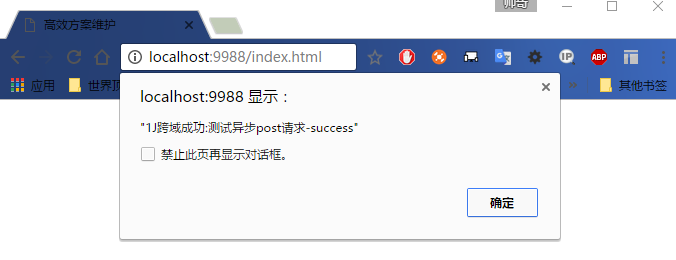 IE10+
IE10+
 firefox
firefox

opera

safari
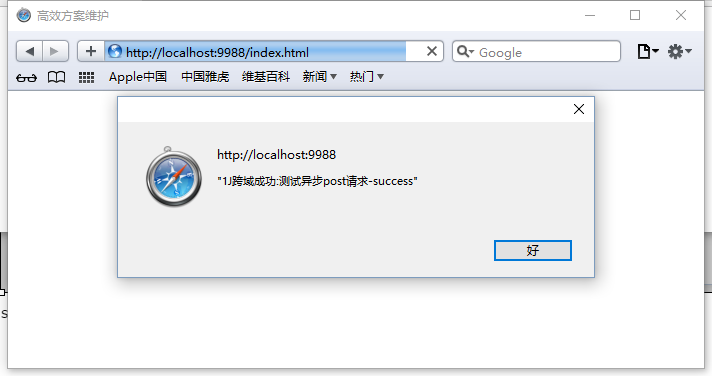
edge
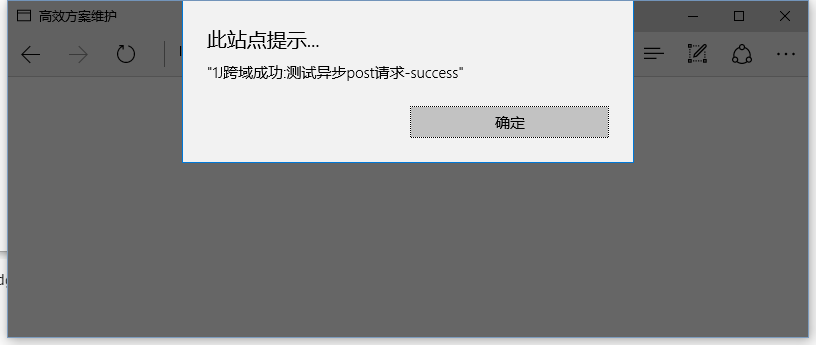
Cross-domain testing:
chrome
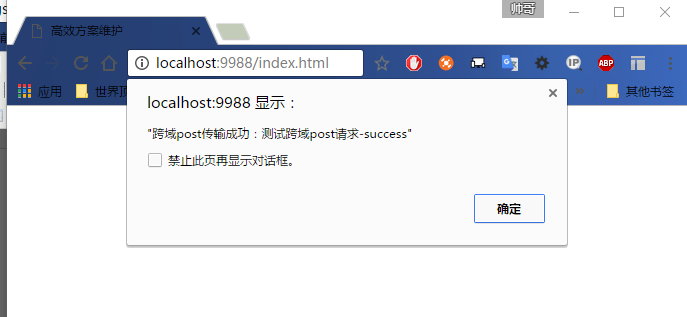
IE8-9

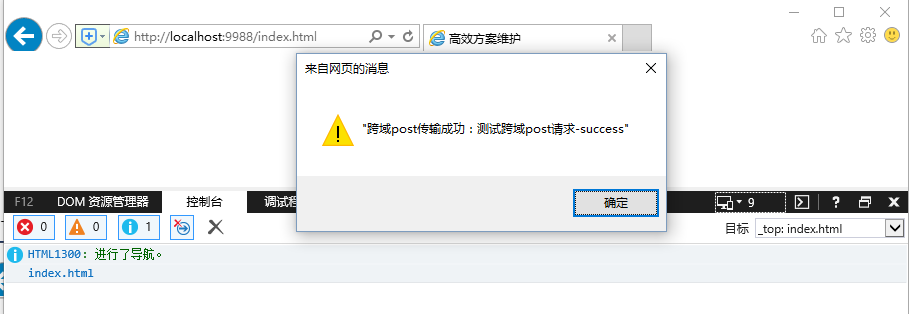
IE10+

firefox
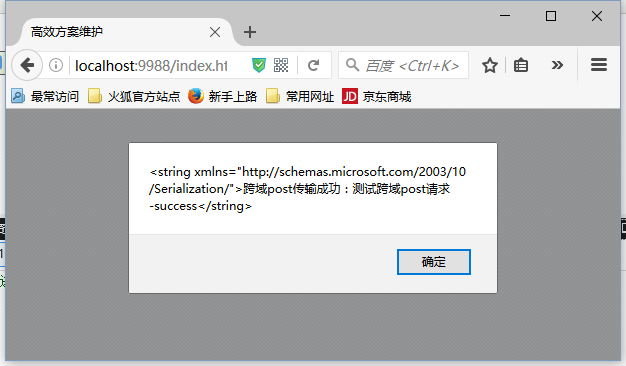
opera
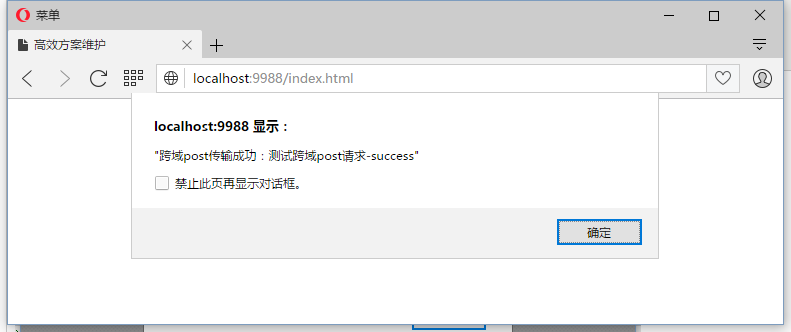
safari

edge
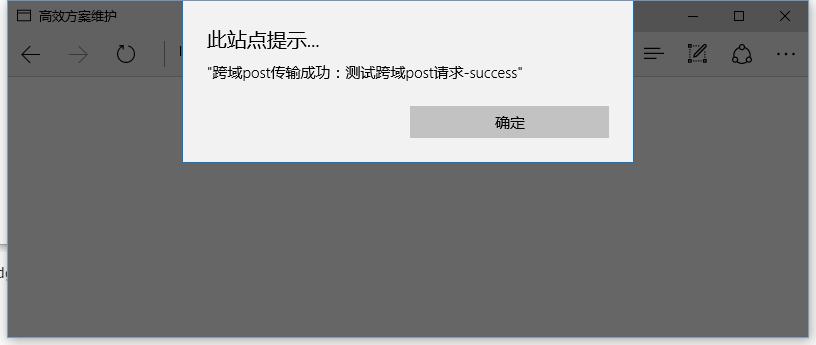
The specific code has been encapsulated into a js library for everyone to develop and customize according to project needs, but I have encapsulated some common requests:
Asynchronous get request -- ajax.get
Asynchronous post request--ajax.post
synchronous get request--ajax.get_sync
synchronous post request--ajax.post_sync
cross-domain get request--ajax.get_cross
cross-domain post request -- ajax.post_cross
Common configuration request -- ajax.common
The code and test page have been uploaded to github. If you want to test the backend interface, just write one yourself. The backend code will not be uploaded. Key compression It’s all over, only 4K!

Hot AI Tools

Undress AI Tool
Undress images for free

Undresser.AI Undress
AI-powered app for creating realistic nude photos

AI Clothes Remover
Online AI tool for removing clothes from photos.

Clothoff.io
AI clothes remover

Video Face Swap
Swap faces in any video effortlessly with our completely free AI face swap tool!

Hot Article

Hot Tools

Notepad++7.3.1
Easy-to-use and free code editor

SublimeText3 Chinese version
Chinese version, very easy to use

Zend Studio 13.0.1
Powerful PHP integrated development environment

Dreamweaver CS6
Visual web development tools

SublimeText3 Mac version
God-level code editing software (SublimeText3)

Hot Topics
 PHP and Ajax: Building an autocomplete suggestion engine
Jun 02, 2024 pm 08:39 PM
PHP and Ajax: Building an autocomplete suggestion engine
Jun 02, 2024 pm 08:39 PM
Build an autocomplete suggestion engine using PHP and Ajax: Server-side script: handles Ajax requests and returns suggestions (autocomplete.php). Client script: Send Ajax request and display suggestions (autocomplete.js). Practical case: Include script in HTML page and specify search-input element identifier.
 How to solve jQuery AJAX request 403 error
Feb 19, 2024 pm 05:55 PM
How to solve jQuery AJAX request 403 error
Feb 19, 2024 pm 05:55 PM
jQuery is a popular JavaScript library used to simplify client-side development. AJAX is a technology that sends asynchronous requests and interacts with the server without reloading the entire web page. However, when using jQuery to make AJAX requests, you sometimes encounter 403 errors. 403 errors are usually server-denied access errors, possibly due to security policy or permission issues. In this article, we will discuss how to resolve jQueryAJAX request encountering 403 error
 How to solve the 403 error encountered by jQuery AJAX request
Feb 20, 2024 am 10:07 AM
How to solve the 403 error encountered by jQuery AJAX request
Feb 20, 2024 am 10:07 AM
Title: Methods and code examples to resolve 403 errors in jQuery AJAX requests. The 403 error refers to a request that the server prohibits access to a resource. This error usually occurs because the request lacks permissions or is rejected by the server. When making jQueryAJAX requests, you sometimes encounter this situation. This article will introduce how to solve this problem and provide code examples. Solution: Check permissions: First ensure that the requested URL address is correct and verify that you have sufficient permissions to access the resource.
 How to solve the problem of jQuery AJAX error 403?
Feb 23, 2024 pm 04:27 PM
How to solve the problem of jQuery AJAX error 403?
Feb 23, 2024 pm 04:27 PM
How to solve the problem of jQueryAJAX error 403? When developing web applications, jQuery is often used to send asynchronous requests. However, sometimes you may encounter error code 403 when using jQueryAJAX, indicating that access is forbidden by the server. This is usually caused by server-side security settings, but there are ways to work around it. This article will introduce how to solve the problem of jQueryAJAX error 403 and provide specific code examples. 1. to make
 How to get variables from PHP method using Ajax?
Mar 09, 2024 pm 05:36 PM
How to get variables from PHP method using Ajax?
Mar 09, 2024 pm 05:36 PM
Using Ajax to obtain variables from PHP methods is a common scenario in web development. Through Ajax, the page can be dynamically obtained without refreshing the data. In this article, we will introduce how to use Ajax to get variables from PHP methods, and provide specific code examples. First, we need to write a PHP file to handle the Ajax request and return the required variables. Here is sample code for a simple PHP file getData.php:
 PHP vs. Ajax: Solutions for creating dynamically loaded content
Jun 06, 2024 pm 01:12 PM
PHP vs. Ajax: Solutions for creating dynamically loaded content
Jun 06, 2024 pm 01:12 PM
Ajax (Asynchronous JavaScript and XML) allows adding dynamic content without reloading the page. Using PHP and Ajax, you can dynamically load a product list: HTML creates a page with a container element, and the Ajax request adds the data to that element after loading it. JavaScript uses Ajax to send a request to the server through XMLHttpRequest to obtain product data in JSON format from the server. PHP uses MySQL to query product data from the database and encode it into JSON format. JavaScript parses the JSON data and displays it in the page container. Clicking the button triggers an Ajax request to load the product list.
 PHP and Ajax: Ways to Improve Ajax Security
Jun 01, 2024 am 09:34 AM
PHP and Ajax: Ways to Improve Ajax Security
Jun 01, 2024 am 09:34 AM
In order to improve Ajax security, there are several methods: CSRF protection: generate a token and send it to the client, add it to the server side in the request for verification. XSS protection: Use htmlspecialchars() to filter input to prevent malicious script injection. Content-Security-Policy header: Restrict the loading of malicious resources and specify the sources from which scripts and style sheets are allowed to be loaded. Validate server-side input: Validate input received from Ajax requests to prevent attackers from exploiting input vulnerabilities. Use secure Ajax libraries: Take advantage of automatic CSRF protection modules provided by libraries such as jQuery.
 What are the ajax versions?
Nov 22, 2023 pm 02:00 PM
What are the ajax versions?
Nov 22, 2023 pm 02:00 PM
Ajax is not a specific version, but a technology that uses a collection of technologies to asynchronously load and update web page content. Ajax does not have a specific version number, but there are some variations or extensions of ajax: 1. jQuery AJAX; 2. Axios; 3. Fetch API; 4. JSONP; 5. XMLHttpRequest Level 2; 6. WebSockets; 7. Server-Sent Events; 8, GraphQL, etc.






